As of the time I’m writing this, there are over 2.5 billion search results for “account-based marketing.” So, what on earth could I say about it that hasn’t already been said?
The thing is, most of that content was written by either ABM technology companies or analysts — people who work around ABM. They may advise brands and help clients get started with account-based strategies, but their business is selling you ABM. And once they’ve done that, they get to back… away… slowly.
I, on the other hand, am a practitioner. I’ve spent the last few years spearheading in-house ABM programs – with a focus on creating new and exciting customer experiences. Some of those ideas have flopped. Others have succeeded. Hell, some have even won ABM awards. (Yep, that’s a thing.)
And with all this experience, I can’t help but share two critical observations right now: First, ABM is an ideal strategy for new client growth during a recession. Second, the “account-based” discipline is still widely misunderstood. So, without further ado, here are seven practical steps you can take to lead an effective ABM program right now.
1. Figure out whether ABM is even a fit for your company.
During a recession, buyers are extra cautious, and you should be, too. After all, account-based marketing is hard work. The results don’t happen automagically, so don’t let anyone sell you ABM (including me) unless it’s the right approach for your business.
ABM could be a great fit for brands that:
- Have a lengthy or complex sales cycle
- Offer somewhat complicated solutions that require a significant investment
- Aren’t well-known and/or aren’t yet the category leaders in terms of market share
Basically, if your company doesn’t consider itself a “challenger brand,” a traditional demand creation program may be a better use of your budget.
2. Build your posse (AKA: “Gain internal alignment”).
Many organizations are abandoning the term “account-based marketing” in favor of “account-based strategies” or “account-based programs.” That’s because the focus on marketing is so misleading. For ABM to be effective, Marketing needs to partner with Sales.
In fact, ITSMA (Information Technology Service Marketing Association) originally coined the term “account-based marketing” with this collaboration in mind:
“ABM is a strategic approach that combines targeted, insight-led marketing with sales to increase mindshare, strengthen relationships, and drive growth in specific new and existing accounts.”
But as we all know, departmental collaboration isn’t as easy as setting up a few meetings at the beginning of a program. You’ll want to get genuine commitment from Sales leadership to make the program successful. And by commitment, I mean shared ownership and responsibilities — not passive approval.
Here’s how an ABM process is different — and a few examples of where you’ll need to align.
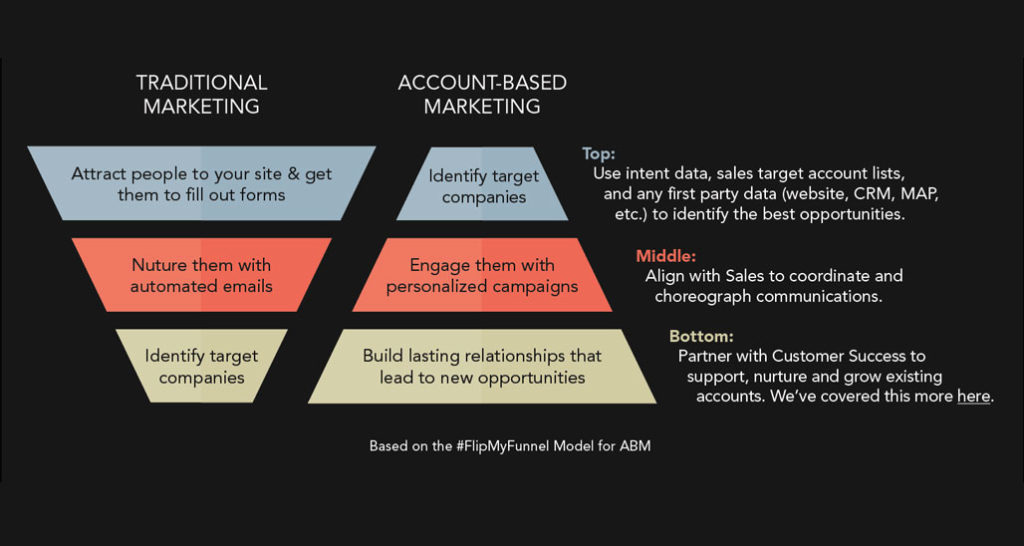
3. Use data & insights to focus on “total-in-market.”
When times get tough, senior leaders often cut costs in part by reducing Marketing budgets. So, you’ll be doing more with less — and that includes media. Rather than going after the “total addressable market” (i.e. anyone that looks like your normal buyer), you’ll need to narrow your focus. Instead, target “total in market,” a limited subset of your audience that has demonstrated recent buying signals.
Marketing and Sales should share the responsibility for categorizing and prioritizing accounts. But in many organizations, Sales is working with an unruly, sprawling list of target accounts. Here are a few steps you can take to whittle down your list:
- Start with commonsense industry-level cuts. Reduce focus on industries hit hardest by economic shifts. Companies that are losing money are less likely to spend.
- Look to your personal connections. Earning a new customer requires trust. Use LinkedIn’s TeamLink feature to see if your teams have any meaningful contacts at your remaining target accounts. It will be far easier to start a conversation or learn if there’s a need if you can get a warm introduction.
- Leverage intent data or proxies for intent. If you can afford to pilot an intent data trial, the investment could help you focus on prospects that have demonstrated specific buying signals. But beware: If there isn’t enough history of listening for your business keywords, the intent data won’t be accurate. Alternatively, your data service provider may also have relevant account-level news and updates. This can provide similar value to intent data if you can monitor the right signals. For example, DiscoverOrg offers “scoops” within their data subscription.
When you know that the right people at the right account are researching information relevant to your solution, spending advertising dollars to reach them isn’t a big gamble. This is the kind of precision that business leadership will gladly support during a recession.
4. Determine the right level of account-specific context.
Too many marketers dismiss ABM because they misunderstand their options when it comes to personalization. They often assume that it’s not ABM unless every account is getting a fully customized campaign approach. This is simply not true.
SiriusDecisions (Forrester) has developed a great model to break down the spectrum of possibilities:
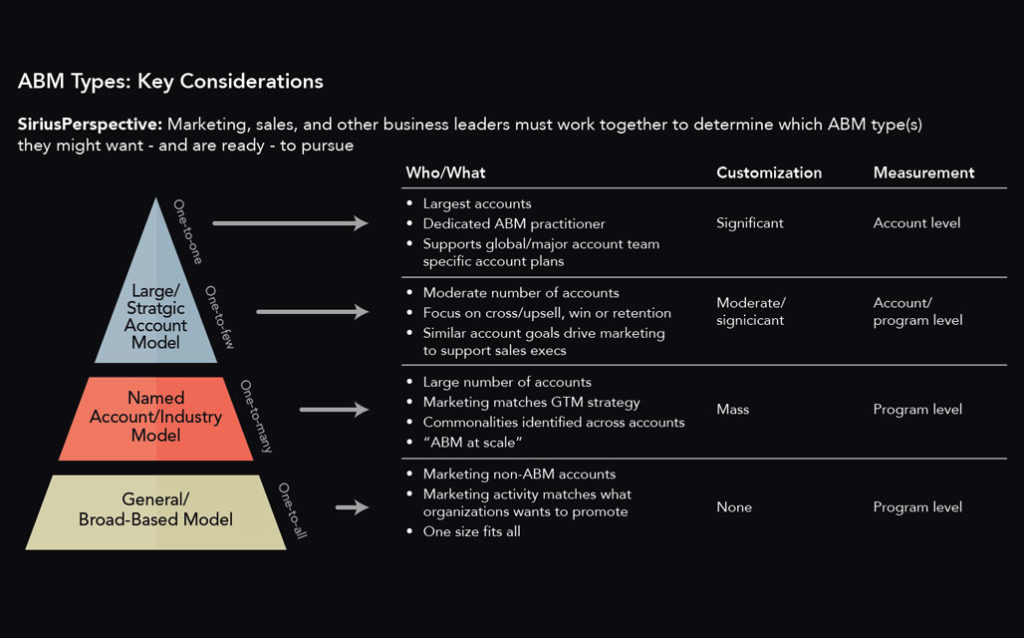
Note: Beware the context-to-content conundrum!
On the other hand, avoid over-customizing your messages if you don’t have the content to back that messaging up. For example, if you lead with a message about how well your solution works in hospitals, the content you’re driving to needs to be primarily about the healthcare vertical.
5. Create the customer experience that no one else will.

Account-based marketing has evolved alongside the mar-tech landscape, so in many ways, the technology companies have been the loudest voices in ABM. Their focus has traditionally been on principles, capabilities, financial benefits and other topics meant to “sell” ABM.
But right now, more than ever, the world needs relevance, empathy and creativity. The stress and anxiety that people are feeling will translate into short attention spans and nervous, extra-reluctant buyers. Here’s what you can do to deliver a truly exceptional customer experience that will strike the right tone and inspire trust.
Connect two truths.
The central idea of any marketing initiative can be expressed as the connection between two truths: A unique truth about your customers and a unique truth about your brand. The goal is to connect these ideas in a memorable way. But, how?
The approach we recommend is to challenge a loosely held belief in a very specific way. Find a popular (but invalid) objection to your solution and challenge it in the most specific, entertaining way possible.
For example, if there’s a misperception that your solution is outdated, point out some leading-edge features with a theme like “Not bad for a provider born in the ‘80s.” Or if customers think of your offering as too expensive, focus on the cost of not adopting it.
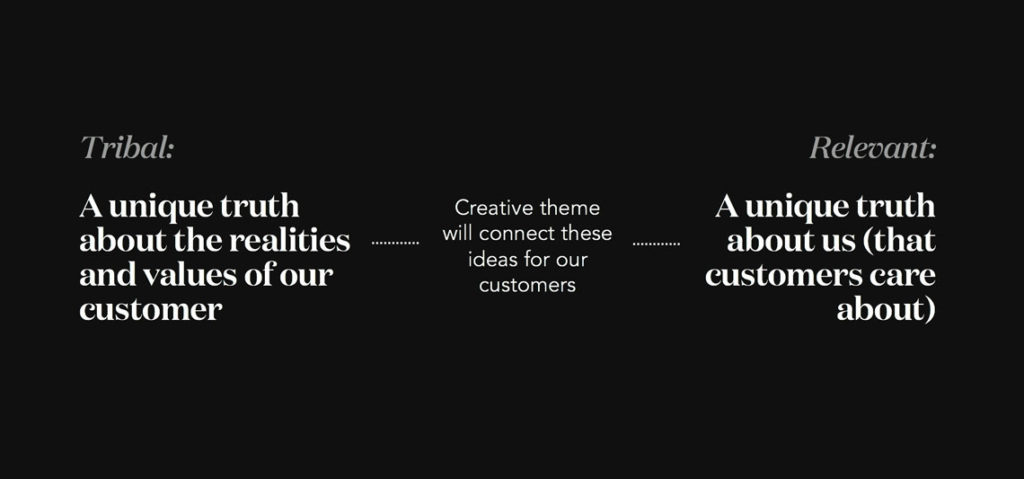
Practice relationship building. (It’s a conversation, not an ad.)
Because customers are extra cautious during a down economy, sales cycles will be delayed. If your marketing wasn’t already designed for the full buying journey, it’s especially important to design for it now.
Too many marketers design personalized “ads” for their target accounts that drive to a let’s-meet CTA on the very first touch. That’s an unrealistic expectation even in the best of times. In general, think about your communications this way:
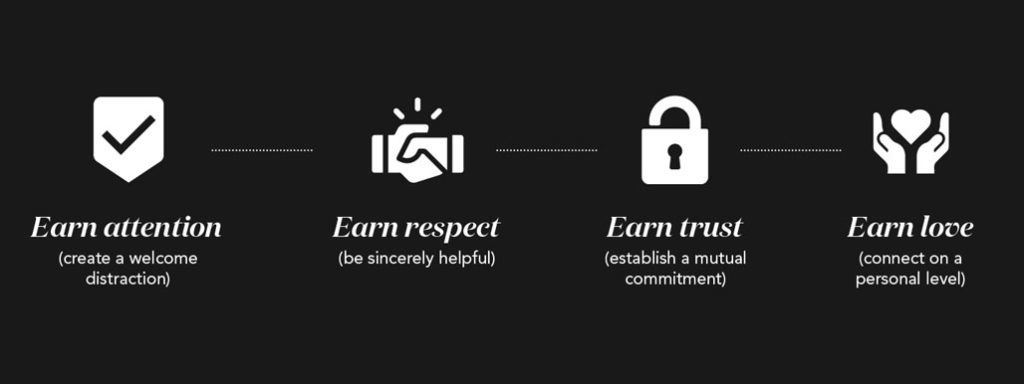
Choreograph sales and marketing touches.
Another common misconception is that there should be a clean handoff from “marketing communications” to “sales communications” with no overlap.
In fact, steady inbound media touches will allow target accounts to see your content and offers and get familiar with your brand, increasing the likelihood that decision-makers will engage with outbound Sales emails.
If these approaches are designed to complement each other, they provide a “surround sound” experience for target accounts — the perception that your brand is everywhere.
Plan for the sales conversation.
B2B brands will likely face a shortage of active Sales conversations during a recession. That means you’ve got to make each one count. Since this is the first in-person experience most prospects will have with your brand, it’s a critical moment.
While I’ve listed this last, it’s actually one of the first things I like to plan. If you think about the first Sales call as an opportunity to deliver an amazing experience and work directly with Sales to bring a dose of creativity to the presentation itself, you can significantly increase the likelihood that opportunities will convert to customers.
For example, a little marketing support can turn “take a meeting with our Sales team” into “schedule a 10-minute learning session and we’ll send you a custom report to educate your leadership about this important topic.” Introductory calls are more appealing when you can make (and deliver on) a specific, valuable promise.
6. Measure your engagement and take action.
Once the program is “activated” (usually meaning when paid media goes live), you’ll need to review performance regularly. This is where ABM becomes a way of working rather than something you’re busy creating.
There’s no one right way to approach this. The engagement metrics and frequency of activity review will be different for each team. I recommend reviewing data at least once or twice per week and meeting weekly with Sales to determine the next best action for each of the most engaged accounts.
In the programs I’ve worked on, we reviewed the following data for each target account:
- Media impressions and click-throughs
- Email opens, click-throughs, and response
- Website visits (media conversion vs. organic) and activity patterns
- Form fills (downloads) or meeting requests
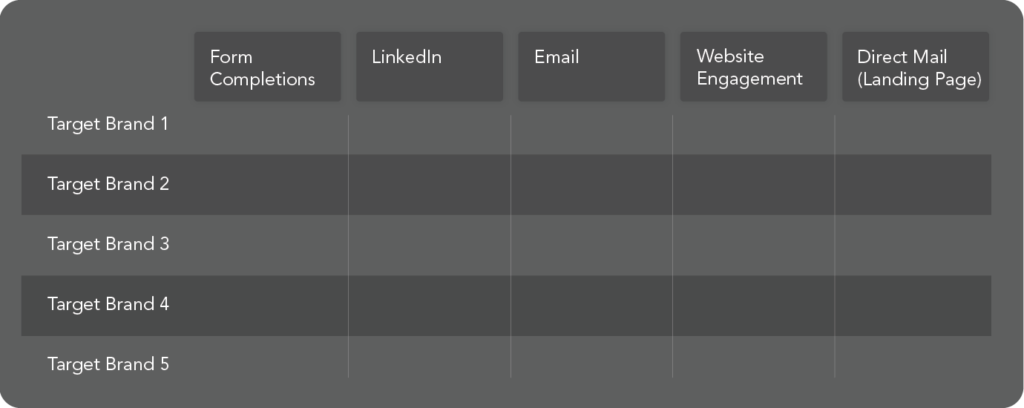
Out-of-the-box dashboards and reporting are a compelling selling point for modern ABM platforms (SaaS). They’ll save you lots of time and energy in manually creating and maintaining your own using Excel, Tableau, etc.
A dedicated ABM platform will also give you the ability to identify and reach specific business buyers, even when they’re working from home, which I’ve covered here.
7. Keep it fresh.
Even if your program works incredibly well at first, be sure to occasionally change up any “always-on” touchpoints like display media. Audiences expect variety.
- Shake up your creative.
When we develop a theme for a large program, we often refer to it as the “creative platform.” That’s because the underlying creative concept should be strong enough to support a wide variety of executions without changing the central message or offer. When it comes to creative strategy, pick a long-distance runner — not a sprinter. - Change up your target accounts.
Economic volatility means that the people and brands you’re targeting will change more regularly. That means you’ll want to refresh any database contacts more regularly. Swap out target accounts as needed to avoid knocking on the wrong door for too long.
Now is the time.
Current circumstances call for a dramatic, strategic shift in B2B marketing plans — and ABM, if implemented correctly, could be your key to continued growth. Here are some additional resources to help you prep for your account-based program.
- Readiness Assessment: SiriusDecisions / Forrester have created a great maturity model to help you ask the right questions prior to undertaking an ABM program.
- Creative Ideas: If you feel like getting physical in your ABM program, here’s some direct mail inspiration.
- Aligning Operations Teams: Aligning operational teams across Marketing, Sales and Customer Success requires change management and discipline. If you aren’t familiar with the recent concept of “Revenue Operations”, here’s a primer.








